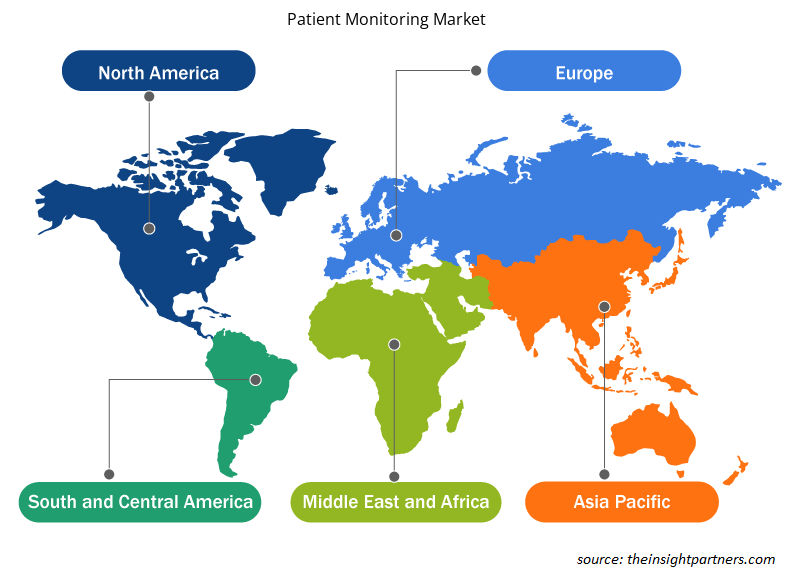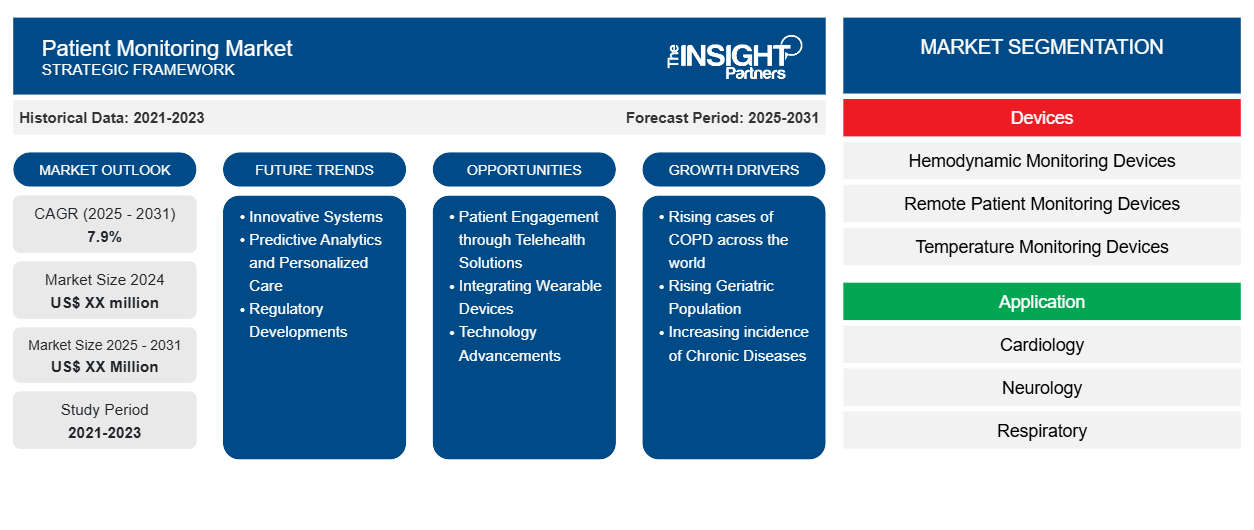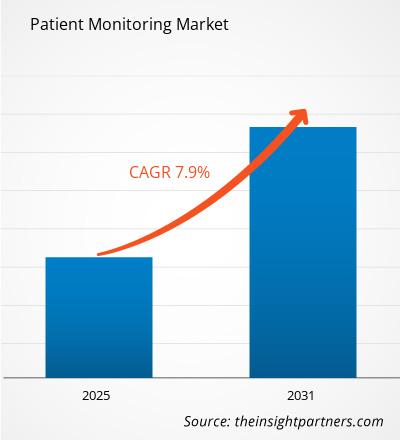Si prevede che il mercato del monitoraggio dei pazienti registrerà un CAGR del 7,9% dal 2023 al 2031, con una dimensione di mercato in espansione da XX milioni di dollari nel 2023 a XX milioni di dollari entro il 2031.
Il report è suddiviso in Monitoraggio dei pazienti tramite dispositivi (Dispositivi di monitoraggio emodinamico, Dispositivi di monitoraggio remoto dei pazienti, Dispositivi di monitoraggio della temperatura, Dispositivi di neuromonitoraggio, Dispositivi di monitoraggio cardiaco, Dispositivi di monitoraggio respiratorio, Dispositivi di monitoraggio multiparametro e altri), Applicazione (Cardiologia, Neurologia, Respiratorio, Fetale e neonatale, Gestione del peso e monitoraggio della forma fisica e Altre applicazioni), Utente finale (Assistenza sanitaria domiciliare, Ospedali e cliniche e Altri utenti finali) e Geografia (Nord America, Europa, Asia Pacifico, Medio Oriente e Africa e Sud e Centro America). L'analisi globale è ulteriormente suddivisa a livello regionale e nei principali paesi. Il report offre il valore in USD per l'analisi e i segmenti di cui sopra.
Scopo del rapporto
Il report Patient Monitoring Market di The Insight Partners mira a descrivere il panorama attuale e la crescita futura, i principali fattori trainanti, le sfide e le opportunità. Ciò fornirà spunti a vari stakeholder aziendali, come:
- Fornitori/produttori di tecnologia: per comprendere le dinamiche di mercato in evoluzione e conoscere le potenziali opportunità di crescita, consentendo loro di prendere decisioni strategiche informate.
- Investitori: condurre un'analisi completa delle tendenze in merito al tasso di crescita del mercato, alle proiezioni finanziarie del mercato e alle opportunità esistenti lungo la catena del valore.
- Enti di regolamentazione: regolamentano le politiche e le attività di controllo sul mercato allo scopo di ridurre al minimo gli abusi, preservare la fiducia degli investitori e sostenere l'integrità e la stabilità del mercato.
Segmentazione del mercato del monitoraggio dei pazienti
Dispositivi
- Dispositivi di monitoraggio emodinamico
- Dispositivi di monitoraggio remoto dei pazienti
- Dispositivi di monitoraggio della temperatura
- Dispositivi di neuromonitoraggio
- Dispositivi di monitoraggio cardiaco
- Dispositivi di monitoraggio respiratorio
- Dispositivi di monitoraggio multiparametro
- Altri
Applicazione
- Cardiologia
- Neurologia
- Respiratorio
- Fetale e neonatale
- Gestione del peso e monitoraggio della forma fisica
- Altre applicazioni
Utente finale
- Assistenza sanitaria domiciliare
- Ospedali e cliniche
- Altri utenti finali
Geografia
- America del Nord
- Europa
- Asia-Pacifico
- America del Sud e Centro
- Medio Oriente e Africa
Geografia
- America del Nord
- Europa
- Asia-Pacifico
- America del Sud e Centro
- Medio Oriente e Africa
Personalizza questo report in base alle tue esigenze
Riceverai la personalizzazione gratuita di qualsiasi report, comprese parti di questo report, o analisi a livello nazionale, pacchetto dati Excel, oltre a usufruire di grandi offerte e sconti per start-up e università
- Scopri le principali tendenze di mercato in questo rapporto.Questo campione GRATUITO includerà analisi di dati che spaziano dalle tendenze di mercato alle stime e alle previsioni.
Driver di crescita del mercato del monitoraggio dei pazienti
- Aumento dei casi di BPCO in tutto il mondo: si prevede che il numero di casi di BPCO aumenterà di 112 milioni, raggiungendo un totale di 592 milioni entro il 2050 (9,5% della popolazione totale idonea), un aumento relativo del 23,3% dal 2020 al 2050. A partire dal 2024, il cancro al seno è il cancro più comune in India, rappresentando il 28,2% di tutti i tumori femminili, con una stima di 216.108 casi entro il 2022
- Aumento della popolazione geriatrica: la popolazione di età pari o superiore a 60 anni è stata stimata in 1 miliardo nel 2020. Entro il 2050, la popolazione mondiale di persone di età pari o superiore a 60 anni raddoppierà (2,1 miliardi). Si prevede che il numero di persone di età pari o superiore a 80 anni triplicherà tra il 2020 e il 2050, raggiungendo i 426 milioni.
- Aumento dell'incidenza delle malattie croniche: più della metà (51,8%) degli adulti ha avuto almeno 1 delle 10 condizioni croniche diagnosticate selezionate (artrite, cancro, broncopneumopatia cronica ostruttiva, coronaropatia, asma in atto, diabete, epatite, ipertensione, ictus e reni deboli o in insufficienza). Circa il 21% degli anziani in India ha segnalato di avere almeno una malattia cronica.
Tendenze future del mercato del monitoraggio dei pazienti
- Sistemi innovativi: l'introduzione di sistemi innovativi è progettata dalle aziende per essere più user-friendly e meno invasivi, assicurando che i pazienti possano ricevere il monitoraggio di cui hanno bisogno senza inutili disagi. Ciò si concentrerà principalmente sull'esperienza del paziente e sul miglioramento della qualità dell'assistenza.
- Analisi predittiva e assistenza personalizzata: nel panorama in rapida evoluzione dell'infrastruttura sanitaria, l'analisi predittiva rappresenta una speranza, trasformando il modo in cui le organizzazioni forniscono assistenza personalizzata. Ad esempio, Mount Sinai Health System, che ha implementato la modellazione predittiva per identificare i pazienti a rischio di sviluppare condizioni croniche e acute.
- Sviluppi normativi: i Centers for Medicare & Medicaid Services (CMS) hanno ampliato l'accesso ai servizi di telemedicina, portando a un aumento del 63% delle visite di telemedicina nel solo 2020. Aziende come Teladoc Health hanno svolto un ruolo cruciale, segnalando oltre 4 milioni di visite virtuali nel primo trimestre del 2021.
Opportunità di mercato per il monitoraggio dei pazienti
- Coinvolgimento del paziente tramite soluzioni di telemedicina: utilizzando videochiamate e servizi di chat, la clinica non solo mantiene la continuità delle cure, ma stabilisce anche un senso di fiducia e comunicazione più profondo con i propri pazienti. La maggior parte degli studi suggerisce che la telemedicina è conveniente, attiva i pazienti e consente loro di rimanere nel loro ambiente naturale per tutto il tempo in cui non lo erano.
- Integrazione di dispositivi indossabili: gli utenti hanno riferito di sentirsi più motivati a fare esercizio regolarmente e ad aderire a stili di vita più sani, dimostrando l'impatto che questi dispositivi possono avere sul benessere generale di un paziente. Funzionalità come contapassi, cardiofrequenzimetri e rilevatori del sonno consentono ai pazienti di raccogliere facilmente dati sui loro comportamenti e abitudini quotidiane.
- Progressi tecnologici: negli ultimi anni, il panorama sanitario è stato trasformato dalle tecnologie emergenti nel monitoraggio remoto dei pazienti (RPM). Un caso interessante è quello di Philips, che ha sviluppato un sistema RPM basato su cloud che consente agli operatori sanitari di monitorare i pazienti con patologie croniche dalle loro case.
Approfondimenti regionali sul mercato del monitoraggio dei pazienti
Le tendenze regionali e i fattori che influenzano il mercato del monitoraggio dei pazienti durante il periodo di previsione sono stati ampiamente spiegati dagli analisti di Insight Partners. Questa sezione discute anche i segmenti e la geografia del mercato del monitoraggio dei pazienti in Nord America, Europa, Asia Pacifico, Medio Oriente e Africa e America meridionale e centrale.

- Ottieni i dati specifici regionali per il mercato del monitoraggio dei pazienti
Ambito del rapporto di mercato sul monitoraggio dei pazienti
| Attributo del report | Dettagli |
|---|---|
| Dimensioni del mercato nel 2023 | XX milioni di dollari USA |
| Dimensioni del mercato entro il 2031 | XX milioni di dollari USA |
| CAGR globale (2023-2031) | 7,9% |
| Dati storici | 2021-2022 |
| Periodo di previsione | 2024-2031 |
| Segmenti coperti | Per dispositivi
|
| Regioni e Paesi coperti | America del Nord
|
| Leader di mercato e profili aziendali chiave |
|
Densità degli operatori del mercato del monitoraggio dei pazienti: comprendere il suo impatto sulle dinamiche aziendali
Il mercato del Patient Monitoring Market sta crescendo rapidamente, spinto dalla crescente domanda degli utenti finali dovuta a fattori quali l'evoluzione delle preferenze dei consumatori, i progressi tecnologici e una maggiore consapevolezza dei benefici del prodotto. Con l'aumento della domanda, le aziende stanno ampliando le loro offerte, innovando per soddisfare le esigenze dei consumatori e capitalizzando sulle tendenze emergenti, il che alimenta ulteriormente la crescita del mercato.
La densità degli operatori di mercato si riferisce alla distribuzione di aziende o società che operano in un particolare mercato o settore. Indica quanti concorrenti (operatori di mercato) sono presenti in un dato spazio di mercato in relazione alle sue dimensioni o al valore di mercato totale.
Le principali aziende che operano nel mercato del monitoraggio dei pazienti sono:
- Honeywell International, Inc
- Assistenza sanitaria Philips
- Farmacia medica Smith
- Medtronic
- Abate
Disclaimer : le aziende elencate sopra non sono classificate secondo un ordine particolare.

- Ottieni una panoramica dei principali attori del mercato del monitoraggio dei pazienti
Punti chiave di vendita
- Copertura completa: il rapporto copre in modo completo l'analisi di prodotti, servizi, tipologie e utenti finali del mercato del monitoraggio dei pazienti, fornendo una panoramica olistica.
- Analisi degli esperti: il rapporto è compilato sulla base della conoscenza approfondita di esperti e analisti del settore.
- Informazioni aggiornate: il rapporto garantisce la pertinenza aziendale grazie alla copertura di informazioni recenti e tendenze nei dati.
- Opzioni di personalizzazione: questo report può essere personalizzato per soddisfare le esigenze specifiche del cliente e adattarsi in modo appropriato alle strategie aziendali.
Il rapporto di ricerca sul mercato del monitoraggio dei pazienti può, quindi, aiutare a guidare il percorso di decodifica e comprensione dello scenario del settore e delle prospettive di crescita. Sebbene possano esserci alcune preoccupazioni valide, i vantaggi complessivi di questo rapporto tendono a superare gli svantaggi.
- Analisi storica (2 anni), anno base, previsione (7 anni) con CAGR
- Analisi PEST e SWOT
- Valore/volume delle dimensioni del mercato - Globale, regionale, nazionale
- Industria e panorama competitivo
- Set di dati Excel



Report Coverage
Revenue forecast, Company Analysis, Industry landscape, Growth factors, and Trends

Segment Covered
This text is related
to segments covered.

Regional Scope
North America, Europe, Asia Pacific, Middle East & Africa, South & Central America

Country Scope
This text is related
to country scope.
Domande frequenti
Rising Geriatric Population
Technological Advancements
Europe held the second largest share in terms of revenue in 2023
Technical expertise is one of the key challenges faced by the overall market
The patient monitoring market is anticipated to witness a CAGR of 7.9% during the forecast period.
Asia Pacific region is expected to witness the highest growth during the forecast period
The List of Companies
1. Honeywell International, Inc
2. Philips Healthcare
3. Smiths Medical
4. Medtronic
5. Abbott
6. Omron Corporation
7. Lifewatch AG
8. Roche Diagnostics
9. Boston Scientific Corporation
10. Nihon Kohden Corporation
11. SCHILLER
12. DEXCOM, INC.
13. SHENZHEN MINDRAY BIO-MEDICAL ELECTRONICS
14. NONIN
15. DRÄGERWERK AG & CO. KGAA
The Insight Partners performs research in 4 major stages: Data Collection & Secondary Research, Primary Research, Data Analysis and Data Triangulation & Final Review.
- Data Collection and Secondary Research:
As a market research and consulting firm operating from a decade, we have published and advised several client across the globe. First step for any study will start with an assessment of currently available data and insights from existing reports. Further, historical and current market information is collected from Investor Presentations, Annual Reports, SEC Filings, etc., and other information related to company’s performance and market positioning are gathered from Paid Databases (Factiva, Hoovers, and Reuters) and various other publications available in public domain.
Several associations trade associates, technical forums, institutes, societies and organization are accessed to gain technical as well as market related insights through their publications such as research papers, blogs and press releases related to the studies are referred to get cues about the market. Further, white papers, journals, magazines, and other news articles published in last 3 years are scrutinized and analyzed to understand the current market trends.
- Primary Research:
The primarily interview analysis comprise of data obtained from industry participants interview and answers to survey questions gathered by in-house primary team.
For primary research, interviews are conducted with industry experts/CEOs/Marketing Managers/VPs/Subject Matter Experts from both demand and supply side to get a 360-degree view of the market. The primary team conducts several interviews based on the complexity of the markets to understand the various market trends and dynamics which makes research more credible and precise.
A typical research interview fulfils the following functions:
- Provides first-hand information on the market size, market trends, growth trends, competitive landscape, and outlook
- Validates and strengthens in-house secondary research findings
- Develops the analysis team’s expertise and market understanding
Primary research involves email interactions and telephone interviews for each market, category, segment, and sub-segment across geographies. The participants who typically take part in such a process include, but are not limited to:
- Industry participants: VPs, business development managers, market intelligence managers and national sales managers
- Outside experts: Valuation experts, research analysts and key opinion leaders specializing in the electronics and semiconductor industry.
Below is the breakup of our primary respondents by company, designation, and region:

Once we receive the confirmation from primary research sources or primary respondents, we finalize the base year market estimation and forecast the data as per the macroeconomic and microeconomic factors assessed during data collection.
- Data Analysis:
Once data is validated through both secondary as well as primary respondents, we finalize the market estimations by hypothesis formulation and factor analysis at regional and country level.
- Macro-Economic Factor Analysis:
We analyse macroeconomic indicators such the gross domestic product (GDP), increase in the demand for goods and services across industries, technological advancement, regional economic growth, governmental policies, the influence of COVID-19, PEST analysis, and other aspects. This analysis aids in setting benchmarks for various nations/regions and approximating market splits. Additionally, the general trend of the aforementioned components aid in determining the market's development possibilities.
- Country Level Data:
Various factors that are especially aligned to the country are taken into account to determine the market size for a certain area and country, including the presence of vendors, such as headquarters and offices, the country's GDP, demand patterns, and industry growth. To comprehend the market dynamics for the nation, a number of growth variables, inhibitors, application areas, and current market trends are researched. The aforementioned elements aid in determining the country's overall market's growth potential.
- Company Profile:
The “Table of Contents” is formulated by listing and analyzing more than 25 - 30 companies operating in the market ecosystem across geographies. However, we profile only 10 companies as a standard practice in our syndicate reports. These 10 companies comprise leading, emerging, and regional players. Nonetheless, our analysis is not restricted to the 10 listed companies, we also analyze other companies present in the market to develop a holistic view and understand the prevailing trends. The “Company Profiles” section in the report covers key facts, business description, products & services, financial information, SWOT analysis, and key developments. The financial information presented is extracted from the annual reports and official documents of the publicly listed companies. Upon collecting the information for the sections of respective companies, we verify them via various primary sources and then compile the data in respective company profiles. The company level information helps us in deriving the base number as well as in forecasting the market size.
- Developing Base Number:
Aggregation of sales statistics (2020-2022) and macro-economic factor, and other secondary and primary research insights are utilized to arrive at base number and related market shares for 2022. The data gaps are identified in this step and relevant market data is analyzed, collected from paid primary interviews or databases. On finalizing the base year market size, forecasts are developed on the basis of macro-economic, industry and market growth factors and company level analysis.
- Data Triangulation and Final Review:
The market findings and base year market size calculations are validated from supply as well as demand side. Demand side validations are based on macro-economic factor analysis and benchmarks for respective regions and countries. In case of supply side validations, revenues of major companies are estimated (in case not available) based on industry benchmark, approximate number of employees, product portfolio, and primary interviews revenues are gathered. Further revenue from target product/service segment is assessed to avoid overshooting of market statistics. In case of heavy deviations between supply and demand side values, all thes steps are repeated to achieve synchronization.
We follow an iterative model, wherein we share our research findings with Subject Matter Experts (SME’s) and Key Opinion Leaders (KOLs) until consensus view of the market is not formulated – this model negates any drastic deviation in the opinions of experts. Only validated and universally acceptable research findings are quoted in our reports.
We have important check points that we use to validate our research findings – which we call – data triangulation, where we validate the information, we generate from secondary sources with primary interviews and then we re-validate with our internal data bases and Subject matter experts. This comprehensive model enables us to deliver high quality, reliable data in shortest possible time.


 Ottieni un campione gratuito per questo repot
Ottieni un campione gratuito per questo repot